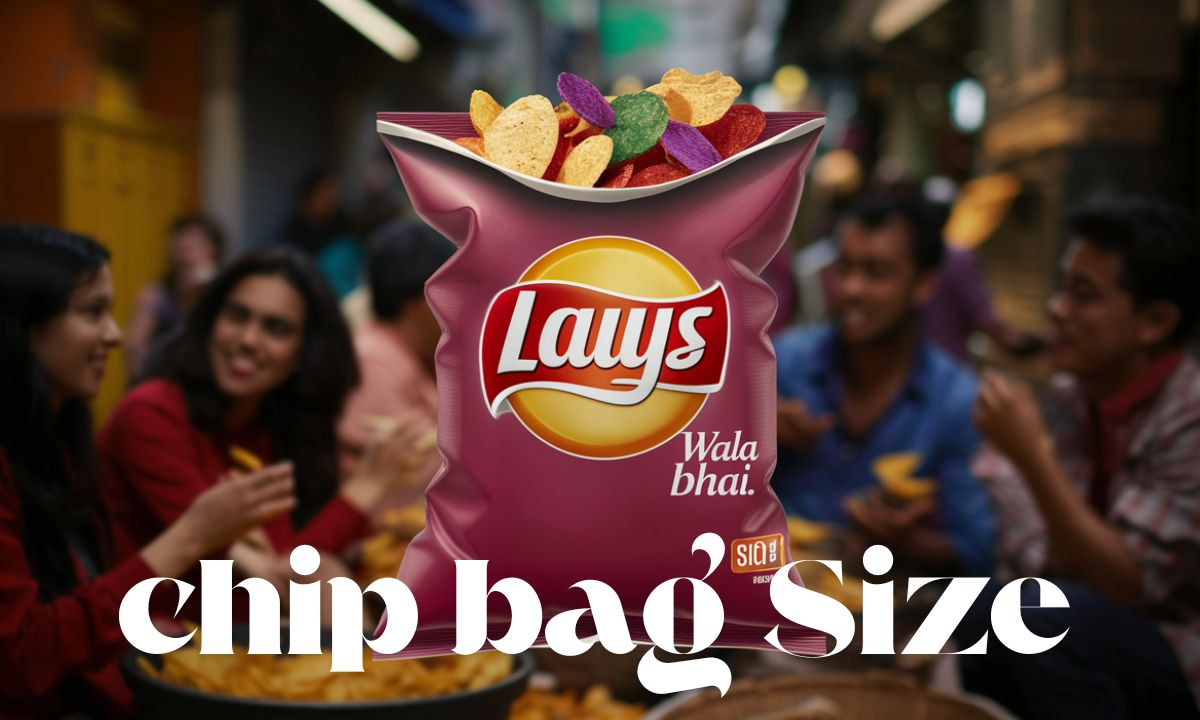Potato chip bag packaging has evolved from simple paper bags to sophisticated multilayer pouches designed for optimal freshness and visual appeal. Modern chip bags incorporate advanced materials and engineering principles to protect contents while maximizing shelf life.
The dimensions of chip bags vary considerably across manufacturers and product lines. Understanding these variations helps consumers make informed purchasing decisions and assists retailers in optimizing shelf space. Package dimensions directly impact storage efficiency, transportation costs, and consumer experience.
Why Packaging Dimensions Matter chip bag
Packaging dimensions play a crucial role in supply chain management and consumer behavior. Accurate measurements enable manufacturers to optimize production, reduce waste, and maintain quality standards. For consumers, understanding bag sizes helps with portion control and value comparison.
Standardized sizing facilitates international trade and regulatory compliance. Different regions have specific requirements for labeling, nutritional information, and environmental impact. These factors influence how manufacturers design chip bag dimensions.
Evolution and Purpose of Chip Bags
The journey from simple paper sacks to today’s sophisticated flexible packaging represents decades of innovation in food science and materials engineering. Early chip bags were primarily made from waxed paper or cellophane, offering minimal protection against moisture and air exposure.
Modern pillow pouches utilize advanced barrier films that combine multiple layers of different materials. These multilayer structures typically include aluminum foil, polyethylene, and specialized coatings that provide superior protection against oxygen, light, and moisture infiltration.
The Psychology Behind Sizing
Consumer psychology plays a significant role in determining optimal chip bag dimensions. Research indicates that package size influences perceived value and consumption patterns. Larger bags create an impression of better value, while smaller packages promote portion control and premium positioning.
Visual perception of package size can be manipulated through design elements such as graphics, colors, and shape modifications. Manufacturers strategically adjust these factors to maximize shelf appeal and encourage purchase decisions.
The Marketing Psychology of Chip Bag Sizes
Marketing strategies heavily influence chip bag sizing decisions across different product categories. Premium brands often utilize smaller, more compact packages to convey quality and exclusivity, while value brands emphasize larger sizes to communicate affordability and abundance.
Brand positioning through package size extends beyond mere economics. Companies carefully balance material costs, transportation efficiency, and consumer expectations to create packages that align with their overall brand strategy and target market preferences.
Standard Chip Bag Sizes and Their Real-World Comparisons
Single-Serve Bags (1–2 oz)
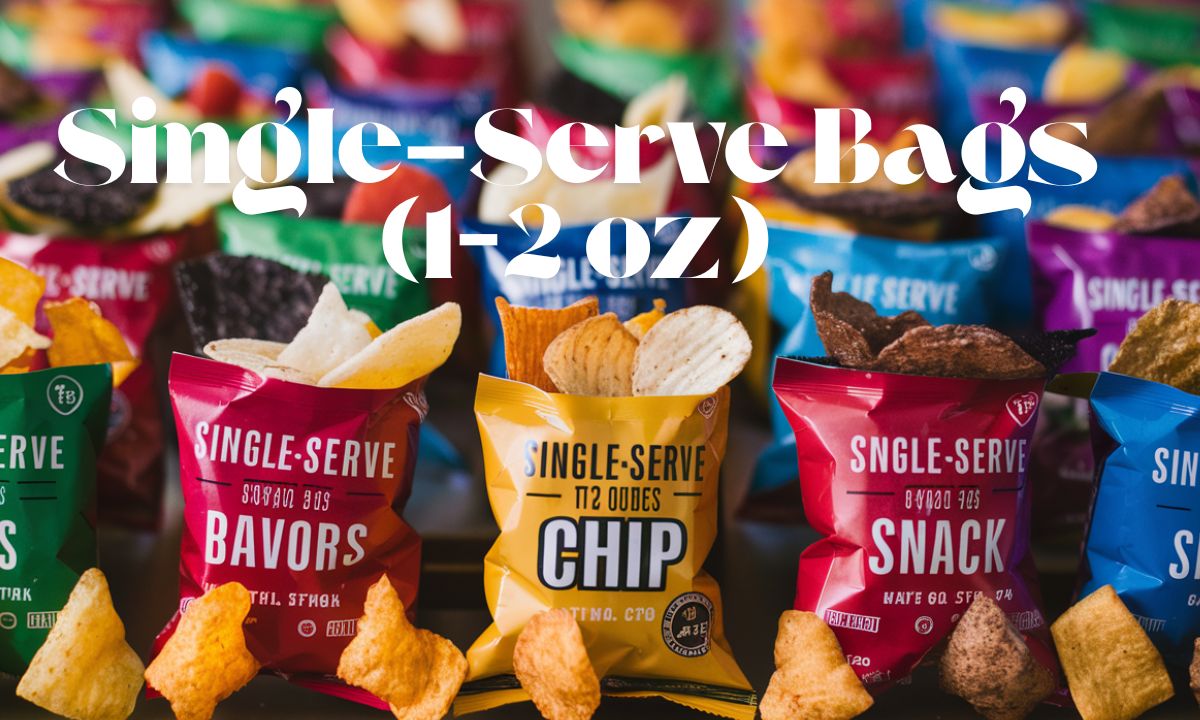
Single-serve portions typically measure approximately 4-5 inches in length and 3-4 inches in width when sealed. These compact packages are designed for individual consumption and convenient portability. The package dimensions closely resemble a standard smartphone screen in terms of overall footprint.
These smaller bags utilize the same barrier materials as larger packages but in reduced quantities. The sealing integrity becomes even more critical due to the higher surface-area-to-volume ratio, requiring precise manufacturing controls to maintain product freshness.
| Package Type | Length (inches) | Width (inches) | Weight (oz) | Common Use |
| Single-Serve | 4-5 | 3-4 | 1-2 | Vending, lunch packs |
| Snack Size | 5-6 | 4-5 | 2-3 | Individual portions |
Regular Size Bags (7–8 oz)
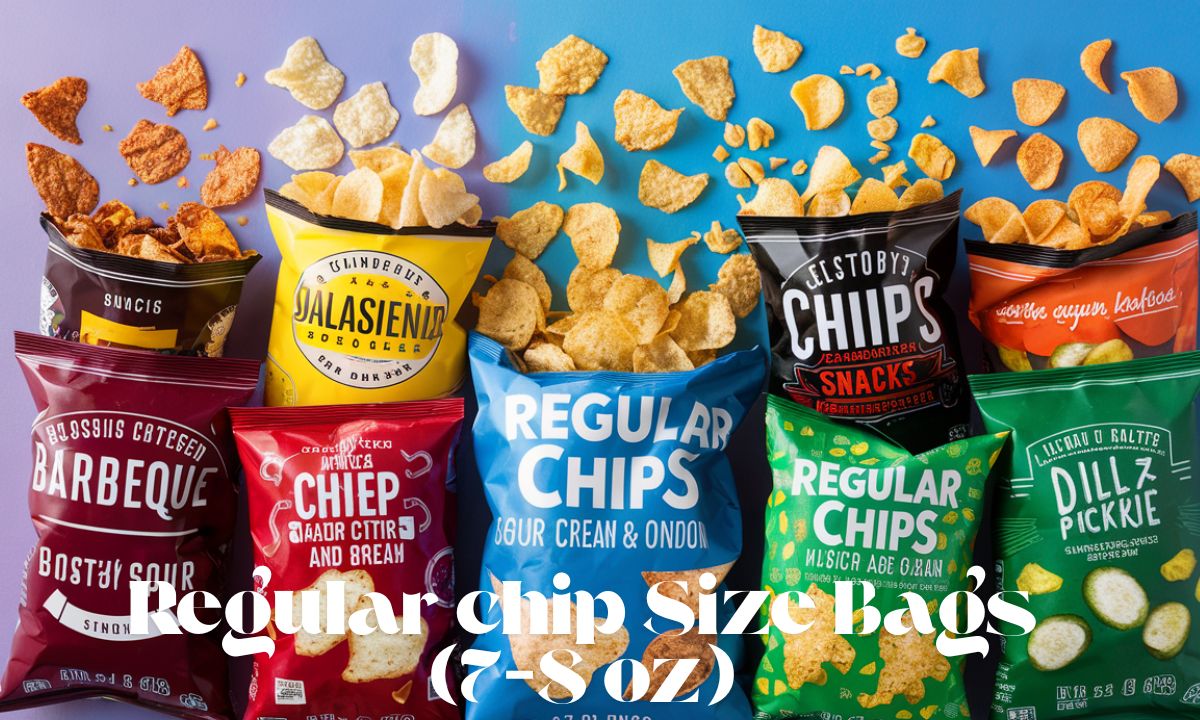
Regular-sized bags represent the most common chip package format found in grocery stores. These packages typically measure 8-10 inches in length and 5-6 inches in width. The dimensions are comparable to a standard tablet computer, making them easily recognizable to consumers.
The structural design of regular bags incorporates reinforced seams and optimized material thickness to withstand normal handling during transportation and retail display. Quality control measures ensure consistent dimensions across production runs.
Family Size Bags (9–10 oz)
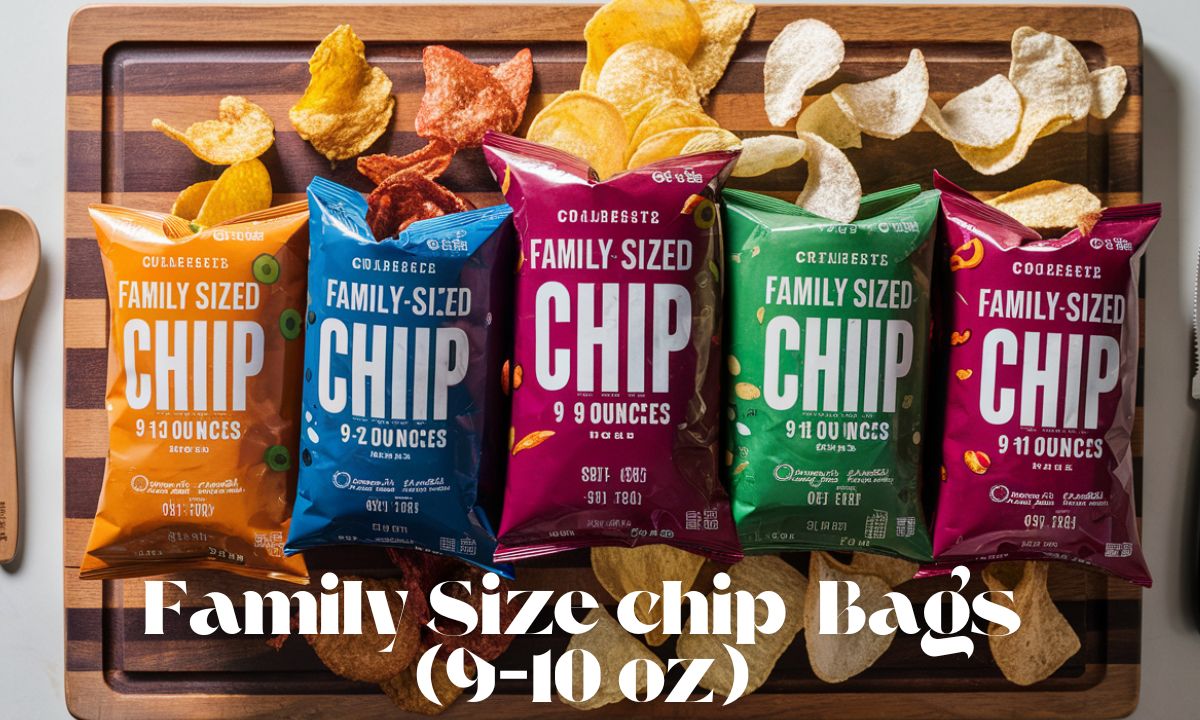
Family-sized packages are designed to serve multiple people and typically measure 10-12 inches in length and 6-7 inches in width. These dimensions allow for efficient stacking and display while providing adequate space for graphics and nutritional information.
The material composition of family-size bags often includes additional reinforcement layers to handle the increased weight and stress from handling. Manufacturing processes must account for the larger dimensions during sealing and quality inspection procedures.
Party Size Bags (13–16 oz)

Party-size bags represent the largest standard format, measuring 12-14 inches in length and 7-8 inches in width. These packages are designed for group consumption and special occasions. The dimensions are similar to a laptop computer screen, making them highly visible on store shelves.
Transportation efficiency becomes a critical consideration for party-size bags due to their increased volume and weight. Manufacturers must balance material costs with structural integrity to ensure products arrive at retail locations in perfect condition.
Practical Comparisons for Standard Bag Sizes
Understanding chip bag dimensions becomes easier when compared to familiar everyday objects. Reference comparisons help consumers quickly assess package sizes without requiring precise measurements:
- Single-serve bags: Similar to a standard greeting card
- Regular bags: Comparable to a paperback book
- Family bags: About the size of a magazine
- Party bags: Similar to a small laptop or large tablet
DIY Measurement Tips Without a Ruler
Alternative measurement methods can help determine chip bag dimensions using common household items. A standard credit card measures approximately 3.375 inches by 2.125 inches, providing a convenient reference for smaller packages.
Hand-span measurements offer another practical approach, as the average adult hand span measures about 7-9 inches from thumb to pinky when fully extended. These natural measuring tools provide reasonable accuracy for most consumer applications.
Deep Dive: 60-Gram Potato Chip Bags
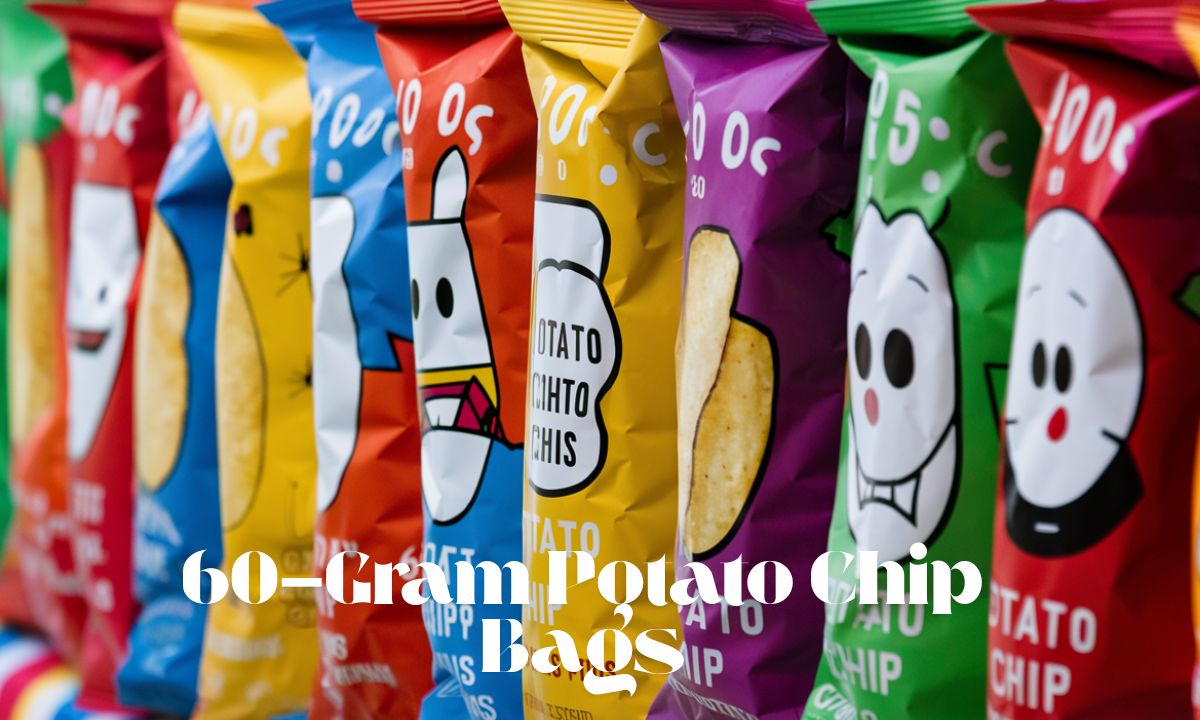
60-gram chip bags represent a popular intermediate size between single-serve and regular packages. These bags typically measure approximately 7-8 inches in length and 4.5-5 inches in width when properly sealed and filled. The package volume is optimized to accommodate the specific weight while maintaining structural integrity.
The dimensional specifications for 60-gram bags must account for the nitrogen flushing process used to displace oxygen and maintain product freshness. This process temporarily inflates the package during manufacturing, requiring precise calculations to achieve final dimensions.
Package Dimension of 60 gr Lay’s Potato Chips Pillow Pouch
Lay’s 60-gram packages utilize a pillow pouch design that measures approximately 7.5 inches in length, 4.8 inches in width, and 2.5 inches in depth when filled. The brand-specific dimensions reflect Lay’s standardized packaging requirements and manufacturing capabilities.
The pillow pouch construction features heat-sealed edges and a distinctive curved shape that maximizes internal volume while minimizing material usage. This engineering approach balances cost efficiency with product protection requirements.
| Specification | Measurement | Tolerance |
| Length | 7.5 inches | ±0.2 inches |
| Width | 4.8 inches | ±0.15 inches |
| Depth (filled) | 2.5 inches | ±0.3 inches |
Package Dimension Test Report of 60 Grams Copico Potato Chips Pillow Pouch
Copico 60-gram packages demonstrate slight variations from Lay’s dimensions due to different manufacturing processes and material specifications. Test measurements indicate lengths of 7.3-7.7 inches and widths of 4.6-5.0 inches across sample batches.
Quality assurance testing reveals that dimensional consistency depends heavily on production line calibration and material properties. Statistical analysis of measurement data helps manufacturers maintain tight tolerances and consistent consumer experience.
Filled Level of 60 Grams of Potato Chips Flushed Bag Pouch
The fill level of nitrogen-flushed 60-gram bags typically reaches 75-85% of total package volume to ensure adequate product protection while minimizing excess air space. This optimization balance protects chips from crushing while avoiding waste of packaging materials.
Nitrogen flushing technology requires precise control of gas flow rates and sealing timing to achieve consistent fill levels across production runs. Process monitoring systems continuously track these parameters to maintain quality standards.
Diecut Line of 60 Grams Potato Chips Flushed Pillow Pouch
Diecut specifications for 60-gram pillow pouches include precision-engineered tear notches and opening features designed for consumer convenience. The diecut pattern typically includes easy-open tabs positioned 1-1.5 inches from the top seal.
Manufacturing precision in diecut operations directly affects consumer satisfaction and package functionality. Quality control measures include regular inspection of cutting tools and dimensional verification of finished products.
Engineering & Materials Behind Chip Bags

Package engineering combines material science, structural mechanics, and manufacturing efficiency to create optimal chip bag dimensions. Engineers must consider factors including barrier properties, mechanical strength, and cost-effectiveness when designing package specifications.
Computer-aided design tools enable precise modeling of package behavior under various conditions including transportation stress, temperature variations, and storage requirements. These simulation capabilities help optimize dimensions before physical prototyping.
The Air Factor – It’s Not Just Empty Space
The nitrogen atmosphere inside chip bags serves multiple critical functions beyond simple cushioning. Inert gas displacement prevents oxidation reactions that would cause rancidity and flavor degradation. The gas volume directly influences package dimensions and appearance.
Gas-to-product ratios are carefully calculated to provide optimal protection while minimizing material waste. Scientific research demonstrates that proper gas flushing can extend shelf life by 200-300% compared to air-packed products.
Foil Materials
Aluminum foil layers in chip bags provide exceptional barrier properties against moisture, oxygen, and light penetration. The metallized films typically measure 0.00035-0.0005 inches in thickness, requiring precise handling during manufacturing processes.
Lamination technology bonds foil layers with plastic films to create composite materials with superior performance characteristics. Advanced adhesives ensure permanent bonding while maintaining flexibility and heat-seal capabilities.
Material Constraints and Physical Limitations
Physical properties of packaging materials impose fundamental constraints on achievable bag dimensions and shapes. Tensile strength, elongation characteristics, and heat-seal parameters define the boundaries of feasible package designs.
Material selection involves balancing multiple competing factors including cost, performance, and environmental impact. Engineering trade-offs require careful analysis to optimize overall package functionality.
Manufacturing Efficiency and Standardization
Production line efficiency depends heavily on standardized package dimensions that minimize changeover times and material waste. Standardization benefits include reduced inventory complexity, simplified quality control procedures, and improved manufacturing throughput.
Industry standards for chip bag dimensions facilitate equipment compatibility and supply chain efficiency. Harmonized specifications enable manufacturers to utilize common production equipment and materials across multiple product lines.
Regional and Cultural Differences in Chip Bag Sizes
Regional and Cultural Variations in Chip Bag Sizes
Geographic differences in chip bag sizes reflect varying consumer preferences, regulatory requirements, and market conditions. European markets typically favor smaller package sizes compared to North American preferences for larger family-oriented packages.
Cultural factors influence portion size expectations and consumption patterns across different regions. Market research indicates that Asian markets prefer smaller individual portions, while American consumers often seek value through larger packages.
International Perspectives
Global standardization efforts in packaging face challenges from diverse regulatory environments and consumer expectations. International trade requirements necessitate flexible packaging designs that can accommodate multiple market needs.
Regulatory compliance varies significantly across regions, affecting allowable materials, labeling requirements, and environmental considerations. Manufacturers must navigate these complexities while maintaining cost-effectiveness and product quality.
Cultural Influences on Packaging
Social customs around snack consumption influence optimal package sizes for different markets. Family structures, eating habits, and lifestyle patterns all contribute to regional preferences for specific bag dimensions.
Brand adaptation strategies often involve modifying package sizes to align with local market expectations while maintaining core product identity and quality standards.
Marketing Strategy and Visual Impact
Price Point Strategy
Pricing psychology heavily influences chip bag sizing decisions across different market segments. Premium positioning often utilizes smaller packages to justify higher per-unit costs, while value brands emphasize larger sizes to communicate affordability.
Market segmentation through package sizing enables manufacturers to target multiple consumer groups with differentiated products. Strategic pricing considers both production costs and perceived value to optimize profitability.
Visual Impact and Shelf Presence
Retail visibility depends on package dimensions that maximize shelf impact while fitting standard display configurations. Merchandising considerations include stackability, facing efficiency, and visual appeal from typical viewing distances.
Brand recognition benefits from consistent dimensional standards that create recognizable shelf presence. Design elements must work effectively across various package sizes to maintain brand coherence.
Environmental Impact and Packaging Innovation
Environmental Impact of Chip Bag Sizes
Sustainability concerns regarding chip bag dimensions focus on material usage efficiency and waste reduction opportunities. Life cycle analysis considers environmental impacts from raw material extraction through end-of-life disposal.
Resource optimization through improved package design can significantly reduce environmental footprint while maintaining product protection performance. Material efficiency improvements benefit both environmental goals and cost reduction objectives.
The Sustainability Question
Environmental responsibility in packaging design requires balancing product protection needs with waste minimization goals. Recyclability considerations influence material selection and package construction methods.
Consumer awareness of environmental issues drives demand for more sustainable packaging solutions. Innovation opportunities exist in developing materials and designs that reduce environmental impact while maintaining functionality.
Innovations in Packaging Efficiency
Technological advances in packaging materials and manufacturing processes enable more efficient use of resources while improving product protection. Smart packaging concepts incorporate sensors and indicators to optimize freshness and reduce waste.
Future developments in packaging technology promise further improvements in sustainability and functionality. Research initiatives focus on biodegradable materials, reduced material usage, and enhanced barrier properties.
Frequently Asked Questions
What is the standard size of a chip bag?
Regular chip bags typically measure 8-10 inches in length and 5-6 inches in width, containing 7-8 ounces of product.
Why do chip bags have so much air?
The “air” is actually nitrogen gas that prevents oxidation and protects chips from crushing during transportation and storage.
How are chip bag dimensions determined?
Manufacturers consider product weight, protection requirements, material costs, and consumer preferences when determining optimal dimensions.
Do chip bag sizes vary by country?
Yes, regional preferences and regulations cause significant variations in standard chip bag sizes across different countries and markets.
What materials are used in chip bags?
Modern chip bags use multilayer films combining aluminum foil, polyethylene, and specialized barrier coatings for optimal product protection.
Conclusion
Chip bag dimensions represent a complex intersection of engineering, marketing, and consumer science that continues evolving with market demands and technological capabilities.
Understanding these dimensional relationships provides insights into the sophisticated processes behind snack packaging.
The future of chip packaging will emphasize sustainability, functionality, and consumer convenience while maintaining protection and shelf appeal that drive purchasing decisions.
Innovation opportunities in materials science and manufacturing promise continued improvements in packaging efficiency and environmental responsibility.
Read More:MarryGeneral.com
